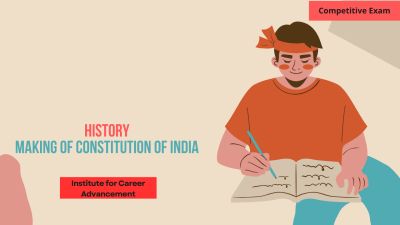Courses


 Compare
Compare
Harappan Civilization, also known as the Indus Valley Civilization, was one of the world's earliest urban cultures, flourishing around 2600 to 1900 BCE in the Indus River Valley, present-day Pakistan and northwest India. It is renowned for its advanced urban planning, sophisticated drainage systems, and highly organized society. The civilization had major cities like Harappa and Mohenjo-Daro, characterized by well-laid-out streets, uniform brick construction, and extensive trade networks. Despite its achievements, much of Harappan culture remains mysterious due to the undeciphered Indus script and the eventual decline of the civilization, possibly due to environmental changes or internal decline. হরপ্পা সভ্যতা, যা সিন্ধু উপত্যকা সভ্যতা নামেও পরিচিত, ছিল বিশ্বের প্রাচীনতম শহুরে সংস্কৃতিগুলির মধ্যে একটি, যা বর্তমান পাকিস্তান এবং উত্তর-পশ্চিম ভারতের সিন্ধু নদী উপত্যকায় প্রায় 2600 থেকে 1900 খ্রিষ্টপূর্বাব্দে বিকশিত হয়েছিল। এটি তার উন্নত নগর পরিকল্পনা, পরিশীলিত নিষ্কাশন ব্যবস্থা এবং অত্যন্ত সংগঠিত সমাজের জন্য বিখ্যাত। সভ্যতায় হরপ্পা এবং মহেঞ্জো-দারোর মতো প্রধান শহরগুলি ছিল, যা সুসজ্জিত রাস্তা, অভিন্ন ইট নির্মাণ এবং বিস্তৃত বাণিজ্য নেটওয়ার্ক দ্বারা চিহ্নিত। এর সাফল্য সত্ত্বেও, হরপ্পা সংস্কৃতির বেশিরভাগই অস্পষ্ট সিন্ধু লিপি এবং সভ্যতার চূড়ান্ত পতনের কারণে রহস্যময় রয়ে গেছে, সম্ভবত পরিবেশগত পরিবর্তন বা অভ্যন্তরীণ পতনের কারণে।
0 Lessons
Hours

 Compare
Compare
Egyptian Civilization refers to one of the world's oldest and most influential ancient cultures, which thrived along the Nile River for over 3,000 years. Known for its monumental achievements, the civilization is famous for the construction of the pyramids, the development of a complex religious system, the use of hieroglyphic writing, and advances in medicine, mathematics, and architecture. The Pharaohs, the kings of Egypt, played a central role in governance and religious practices, overseeing monumental projects like the Great Pyramids of Giza and the Sphinx. Egyptian society was deeply intertwined with religion, and their legacy continues to influence art, architecture, and culture today. মিশরীয় সভ্যতা বিশ্বের প্রাচীনতম এবং সবচেয়ে প্রভাবশালী প্রাচীন সংস্কৃতিকে বোঝায়, যা 3,000 বছরেরও বেশি সময় ধরে নীল নদের তীরে সমৃদ্ধ হয়েছিল। তার স্মরণীয় কৃতিত্বের জন্য পরিচিত, সভ্যতাটি পিরামিড নির্মাণ, একটি জটিল ধর্মীয় ব্যবস্থার বিকাশ, হায়ারোগ্লিফিক লেখার ব্যবহার এবং চিকিৎসা, গণিত এবং স্থাপত্যের অগ্রগতির জন্য বিখ্যাত। মিশরের রাজা ফারাওরা শাসন ও ধর্মীয় অনুশীলনে কেন্দ্রীয় ভূমিকা পালন করেছিলেন, গিজার গ্রেট পিরামিড এবং স্ফিংক্সের মতো স্মৃতিসৌধ প্রকল্পগুলির তদারকি করেছিলেন। মিশরীয় সমাজ ধর্মের সঙ্গে গভীরভাবে জড়িত ছিল এবং তাদের উত্তরাধিকার আজও শিল্প, স্থাপত্য এবং সংস্কৃতিকে প্রভাবিত করে চলেছে।
0 Lessons
Hours

 Compare
Compare
Mesopotamian Civilization refers to one of the world’s earliest and most influential ancient civilizations, located in the region between the Tigris and Euphrates rivers, in present-day Iraq and parts of Syria and Turkey. Known as the "Cradle of Civilization," Mesopotamia gave birth to some of the first urban societies, including the Sumerians, Akkadians, Babylonians, and Assyrians. This civilization is renowned for its innovations in writing (cuneiform), law (Code of Hammurabi), architecture (ziggurats), and advancements in mathematics, astronomy, and agriculture. The rich cultural, religious, and political legacy of Mesopotamia laid the foundations for many aspects of modern civilization. মেসোপটেমিয়ার সভ্যতা বলতে বিশ্বের প্রাচীনতম এবং সবচেয়ে প্রভাবশালী প্রাচীন সভ্যতাকে বোঝায়, যা বর্তমান ইরাকের টাইগ্রিস এবং ইউফ্রেটিস নদীর মধ্যবর্তী অঞ্চলে এবং সিরিয়া ও তুরস্কের কিছু অংশে অবস্থিত। "সভ্যতার জন্মস্থান" নামে পরিচিত মেসোপটেমিয়া সুমেরীয়, আক্কাদীয়, ব্যাবিলনীয় এবং অ্যাসিরীয় সহ প্রথম কিছু শহুরে সমাজের জন্ম দেয়। এই সভ্যতা লিখিত (কিউনিফর্ম) আইন (হাম্মুরাবির কোড) স্থাপত্য (জিগ্গুরাত) এবং গণিত, জ্যোতির্বিজ্ঞান এবং কৃষিতে অগ্রগতির জন্য বিখ্যাত। মেসোপটেমিয়ার সমৃদ্ধ সাংস্কৃতিক, ধর্মীয় এবং রাজনৈতিক উত্তরাধিকার আধুনিক সভ্যতার অনেক দিকের ভিত্তি স্থাপন করেছিল।
0 Lessons
Hours

 Compare
Compare
The Sufi Movement was a spiritual and mystical movement within Islam that emphasized the inner, personal experience of the divine through direct connection and love for God, rather than through external rituals or formal theology. Originating in the early centuries of Islam, Sufism spread across the Islamic world, including India, where it played a significant role in shaping religious practices and promoting spiritual unity. Sufi practitioners, known as Sufis, often sought to experience the divine through meditation, poetry, music (like Qawwali), and ascetic practices. The movement emphasized tolerance, non-violence, and social harmony, creating an inclusive approach to spirituality that transcended religious and cultural boundaries. The Sufi orders (such as the Chishti, Qadiri, and Suhrawardi orders) became influential in spreading Islam in India and fostering interfaith dialogue. সুফি আন্দোলন ছিল ইসলামের মধ্যে একটি আধ্যাত্মিক ও রহস্যময় আন্দোলন যা বাহ্যিক আচার বা আনুষ্ঠানিক ধর্মতত্ত্বের পরিবর্তে সরাসরি সংযোগ এবং ঈশ্বরের প্রতি ভালবাসার মাধ্যমে ঐশ্বরিকের অভ্যন্তরীণ, ব্যক্তিগত অভিজ্ঞতার উপর জোর দিয়েছিল। ইসলামের প্রথম শতাব্দীতে উদ্ভূত, সুফিবাদ ভারত সহ ইসলামী বিশ্বে ছড়িয়ে পড়ে, যেখানে এটি ধর্মীয় অনুশীলনকে রূপ দিতে এবং আধ্যাত্মিক ঐক্যের প্রচারে গুরুত্বপূর্ণ ভূমিকা পালন করে। সুফি হিসাবে পরিচিত সুফি অনুশীলনকারীরা প্রায়শই ধ্যান, কবিতা, সঙ্গীত (কাওয়ালীর মতো) এবং তপস্বী অনুশীলনের মাধ্যমে ঐশ্বরিক অভিজ্ঞতা অর্জন করতে চেয়েছিলেন। আন্দোলনটি সহনশীলতা, অহিংসা এবং সামাজিক সম্প্রীতির উপর জোর দেয়, আধ্যাত্মিকতার জন্য একটি অন্তর্ভুক্তিমূলক দৃষ্টিভঙ্গি তৈরি করে যা ধর্মীয় ও সাংস্কৃতিক সীমানা অতিক্রম করে। সুফি আদেশগুলি (যেমন চিশতি, কাদিরি এবং সোহরাওয়ার্দী আদেশ) ভারতে ইসলাম ছড়িয়ে দিতে এবং আন্তঃধর্মীয় সংলাপকে উৎসাহিত করতে প্রভাবশালী হয়ে ওঠে।
0 Lessons
Hours

 Compare
Compare
The Bhakti Movement was a significant religious and social movement in medieval India, emphasizing devotion to a personal god over ritualistic practices. Originating in the 7th century and flourishing between the 12th and 17th centuries, it promoted the idea that devotion (bhakti), regardless of caste, gender, or social status, could lead one to salvation. Key figures like Ramanuja, Kabir, Guru Nanak, Mirabai, and Tulsidas championed the movement, often challenging established religious authorities and caste systems. The Bhakti Movement helped democratize spirituality, fostering religious tolerance, social reform, and a deeper connection to the divine through poetry, music, and personal devotion. ভক্তি আন্দোলন মধ্যযুগীয় ভারতে একটি উল্লেখযোগ্য ধর্মীয় ও সামাজিক আন্দোলন ছিল, যা ধর্মীয় অনুশীলনের চেয়ে ব্যক্তিগত দেবতার প্রতি ভক্তির উপর জোর দিয়েছিল। সপ্তম শতাব্দীতে উদ্ভূত এবং 12শ থেকে 17শ শতাব্দীর মধ্যে বিকশিত হয়ে, এটি এই ধারণাকে উন্নীত করেছিল যে জাতি, লিঙ্গ বা সামাজিক মর্যাদা নির্বিশেষে ভক্তি (ভক্তি) একজনকে পরিত্রাণের দিকে নিয়ে যেতে পারে। রামানুজ, কবির, গুরু নানক, মীরাবাঈ এবং তুলসীদাসের মতো প্রধান ব্যক্তিত্বরা প্রায়শই প্রতিষ্ঠিত ধর্মীয় কর্তৃপক্ষ এবং বর্ণ ব্যবস্থাকে চ্যালেঞ্জ জানিয়ে এই আন্দোলনকে সমর্থন করেছিলেন। ভক্তি আন্দোলন আধ্যাত্মিকতাকে গণতান্ত্রিক করতে, ধর্মীয় সহনশীলতা, সামাজিক সংস্কার এবং কবিতা, সঙ্গীত এবং ব্যক্তিগত ভক্তির মাধ্যমে ঐশ্বরিকতার সাথে গভীর সংযোগ গড়ে তুলতে সহায়তা করেছিল।
0 Lessons
Hours

 Compare
Compare
The Vijayanagara Empire (1336–1646) was a powerful South Indian kingdom founded by Harihara I and Bukka Raya I. It flourished under successive rulers and became one of the most significant empires in Indian history. Located in present-day Karnataka, it was known for its advanced administration, flourishing trade, and impressive cultural achievements, particularly in art, architecture, and literature. The capital, Hampi, is renowned for its stunning architecture and was a center of commerce and learning. Alongside Vijayanagara, other important kingdoms such as the Bahmani Sultanate (1347–1527) in the Deccan, the Chola Empire (which continued to influence the region until the 13th century), and the Gajapatis of Odisha, played crucial roles in shaping South India's political and cultural landscape during this period. These kingdoms were often in conflict with each other, but they also contributed to the rich diversity of South Indian civilization. বিজয়নগর সাম্রাজ্য (1336-1646) প্রথম হরিহর এবং প্রথম বুক্কা রায় দ্বারা প্রতিষ্ঠিত একটি শক্তিশালী দক্ষিণ ভারতীয় রাজ্য ছিল। এটি পরবর্তী শাসকদের অধীনে বিকশিত হয়েছিল এবং ভারতীয় ইতিহাসের অন্যতম গুরুত্বপূর্ণ সাম্রাজ্যে পরিণত হয়েছিল। বর্তমান কর্ণাটকে অবস্থিত, এটি তার উন্নত প্রশাসন, সমৃদ্ধ বাণিজ্য এবং বিশেষত শিল্প, স্থাপত্য ও সাহিত্যে চিত্তাকর্ষক সাংস্কৃতিক কৃতিত্বের জন্য পরিচিত ছিল। রাজধানী হাম্পি তার অত্যাশ্চর্য স্থাপত্যের জন্য বিখ্যাত এবং বাণিজ্য ও শিক্ষার কেন্দ্র ছিল। বিজয়নগরের পাশাপাশি অন্যান্য গুরুত্বপূর্ণ রাজ্য যেমন দাক্ষিণাত্যের বাহমনি সালতানাত (1347-1527), চোল সাম্রাজ্য (যা 13শ শতাব্দী পর্যন্ত এই অঞ্চলটিকে প্রভাবিত করে চলেছিল) এবং ওড়িশার গজপতিরা এই সময়কালে দক্ষিণ ভারতের রাজনৈতিক ও সাংস্কৃতিক দৃশ্যপট গঠনে গুরুত্বপূর্ণ ভূমিকা পালন করেছিল। এই রাজ্যগুলি প্রায়শই একে অপরের সাথে দ্বন্দ্বে লিপ্ত থাকত, তবে তারা দক্ষিণ ভারতীয় সভ্যতার সমৃদ্ধ বৈচিত্র্যেও অবদান রেখেছিল।
0 Lessons
Hours

 Compare
Compare
The Delhi Sultanate (1206–1526) was a series of Muslim dynasties that ruled much of northern India from Delhi. It marked the beginning of Muslim rule in India and had a significant impact on the political, cultural, and architectural landscape of the subcontinent. The Sultanate was founded by Qutb-ud-Din Aibak after the decline of the Ghaznavid Empire. It saw the rise and fall of several dynasties, including the Mamluk, Khilji, Tughlaq, Sayyid, and Lodi dynasties. The Sultanate played a crucial role in establishing Islam as a major religion in India and also witnessed the flourishing of Indo-Islamic culture. Its rule ended with the rise of the Mughal Empire in 1526. দিল্লি সালতানাত (1206-1526) ছিল মুসলিম রাজবংশের একটি সিরিজ যা দিল্লি থেকে উত্তর ভারতের বেশিরভাগ অংশ শাসন করেছিল। এটি ভারতে মুসলিম শাসনের সূচনা করে এবং উপমহাদেশের রাজনৈতিক, সাংস্কৃতিক ও স্থাপত্যের ভূদৃশ্যের উপর উল্লেখযোগ্য প্রভাব ফেলে। গজনবীয় সাম্রাজ্যের পতনের পর কুতুব-উদ-দীন আইবক সালতানাত প্রতিষ্ঠা করেন। এটি মামলুক, খিলজি, তুঘলক, সৈয়দ এবং লোদি রাজবংশ সহ বেশ কয়েকটি রাজবংশের উত্থান ও পতন দেখেছিল। সুলতানি ভারতে ইসলামকে একটি প্রধান ধর্ম হিসাবে প্রতিষ্ঠিত করতে গুরুত্বপূর্ণ ভূমিকা পালন করেছিল এবং ইন্দো-ইসলামিক সংস্কৃতির বিকাশও প্রত্যক্ষ করেছিল। 1526 খ্রিষ্টাব্দে মুঘল সাম্রাজ্যের উত্থানের সঙ্গে সঙ্গে এর শাসন শেষ হয়।
0 Lessons
Hours

 Compare
Compare
The Making of the Constitution of India refers to the process through which India created its supreme legal document after gaining independence in 1947. The Constituent Assembly, formed in 1946, was tasked with drafting the Constitution. Led by figures like Dr. B.R. Ambedkar (the principal architect), the Assembly debated and shaped the Constitution over nearly three years, finalizing it on November 26, 1949. The Constitution came into effect on January 26, 1950, marking India as a sovereign, democratic republic. It is one of the longest and most detailed constitutions in the world, establishing India’s political framework, including fundamental rights, governance structure, and the relationship between the state and citizens. ভারতের সংবিধান প্রণয়ন বলতে সেই প্রক্রিয়াকে বোঝায় যার মাধ্যমে 1947 সালে স্বাধীনতা অর্জনের পর ভারত তার সর্বোচ্চ আইনি নথি তৈরি করে। 1946 সালে গঠিত গণপরিষদকে সংবিধানের খসড়া তৈরি করার দায়িত্ব দেওয়া হয়েছিল। ডঃ B.R মত পরিসংখ্যান দ্বারা পরিচালিত। আম্বেদকর (প্রধান স্থপতি) বিধানসভা প্রায় তিন বছর ধরে সংবিধান নিয়ে বিতর্ক ও গঠন করে, 1949 সালের 26শে নভেম্বর এটি চূড়ান্ত করে। 1950 সালের 26শে জানুয়ারি সংবিধান কার্যকর হয়, যা ভারতকে একটি সার্বভৌম, গণতান্ত্রিক প্রজাতন্ত্র হিসাবে চিহ্নিত করে। এটি বিশ্বের দীর্ঘতম এবং বিস্তারিত সংবিধানগুলির মধ্যে একটি, যা মৌলিক অধিকার, প্রশাসনিক কাঠামো এবং রাষ্ট্র ও নাগরিকদের মধ্যে সম্পর্ক সহ ভারতের রাজনৈতিক কাঠামো প্রতিষ্ঠা করে।
0 Lessons
Hours

 Compare
Compare
Independence with Partition refers to the moment in 1947 when British India gained independence, leading to the creation of two separate nations: India and Pakistan. The partition was a result of mounting religious tensions between Hindus and Muslims, which led to the division of the subcontinent into a Hindu-majority India and a Muslim-majority Pakistan. The partition caused widespread violence, mass migrations, and significant loss of life, as millions of people were displaced along the newly drawn borders. Pakistan was created on August 14, 1947, while India gained independence on August 15, 1947. The partition remains one of the most traumatic and defining events in the history of both nations. দেশভাগের সঙ্গে স্বাধীনতা 1947 সালের সেই মুহূর্তকে বোঝায় যখন ব্রিটিশ ভারত স্বাধীনতা অর্জন করেছিল, যার ফলে দুটি পৃথক জাতি তৈরি হয়েছিলঃ ভারত ও পাকিস্তান। এই বিভাজন হিন্দু ও মুসলমানদের মধ্যে ক্রমবর্ধমান ধর্মীয় উত্তেজনার ফল ছিল, যার ফলে উপমহাদেশটি হিন্দু-সংখ্যাগরিষ্ঠ ভারত এবং মুসলিম-সংখ্যাগরিষ্ঠ পাকিস্তানে বিভক্ত হয়েছিল। দেশভাগের ফলে ব্যাপক সহিংসতা, গণ অভিবাসন এবং উল্লেখযোগ্য প্রাণহানির ঘটনা ঘটে, কারণ লক্ষ লক্ষ মানুষ নতুন টানা সীমান্তে বাস্তুচ্যুত হয়েছিল। 1947 সালের 14ই আগস্ট পাকিস্তান গঠিত হয় এবং 1947 সালের 15ই আগস্ট ভারত স্বাধীনতা লাভ করে। এই বিভাজন উভয় দেশের ইতিহাসে সবচেয়ে বেদনাদায়ক এবং সংজ্ঞায়িত ঘটনাগুলির মধ্যে একটি।
0 Lessons
Hours